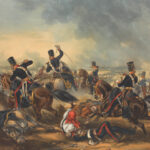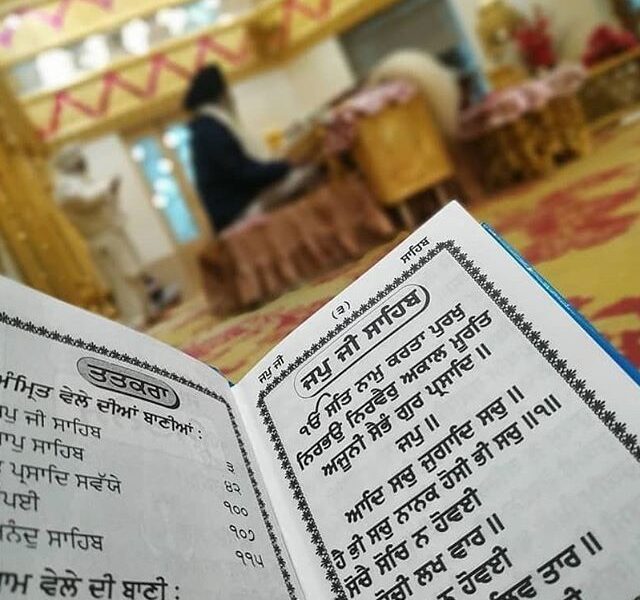Symbol of pride and honor
The Pagg, also recognized as Dastaar or Turban, stands as a symbol of pride and honor for Sikh men. Crafted from a lengthy piece of cotton, the Pagg is tied to create a majestic head covering. This art of tying the Pagg is passed down through generations, with styles often reflecting regional or personal preferences.
More than a mere garment, the Pagg is a visible manifestation of a Sikh’s unwavering commitment to their faith and the values it encompasses.
The turban has held profound significance in Sikh culture since the era of the Sixth Guru. During the transition from Guru Ram Das to Guru Arjan Dev, the turban symbolized the transfer of Guruship, with Guru Arjan Dev being honored with this sacred headwear. Following the passing of the Guru, Pirthi Chand, the elder son, donned a special turban, a customary practice for the eldest son when the father transitions.
Marne di pag Pirthiye badhi. Guriyaee pag Arjan LadhiAs Guru Gobind Singh, the last human Sikh Guru, expressed, “Brush your hair two times daily and tie your turban neatly, one step at a time.”
Kangha dono vakt kar, paag chune kar bandhai.In the early Sikh historical text, Sri Gur Panth Parkash, Bhai Rattan Singh Bhangu conveyed the importance of maintaining Sikh traditions:
“Tie your turban twice daily, wear your weapons to protect your beliefs, and keep them safe all day. Take good care of your hair; don’t cut or damage it.”
Doi vele utth bandhyo dastare, pahar aatth rakhyo shastar sambhare
Kesan ki kijo pritpal, nah(i) ustran se katyo vaalThese teachings and traditions surrounding the turban underscore its role not only as a symbol of cultural and spiritual significance but also as a tangible representation of leadership and honor within the Sikh community.
The dastār is a symbol of spirituality, holiness, and humility in Sikhism. The dastār is also a symbol of honour and self-respect. In the Punjabi culture, those who have selflessly served the community are traditionally honoured with turbans.
Sharing Turbans: A Special Tradition
In Punjab, people have been exchanging turbans for a very long time. This tradition is a way of creating strong connections and friendships. When someone shares a turban with another person, it’s not just about the cloth on their heads. It’s a meaningful way of building relationships that lasts for a long time, connecting the past with the present.
Turban: A Symbol of Responsibility
Tying a turban not only signifies honor and self-esteem but also carries the weight of responsibility. Throughout history, Sikh soldiers, in times of war, have proudly worn turbans as a symbol of their duty and commitment.

Bhai Randhir Singh Jheel’s unwavering dedication, even risking his life, to secure the right to wear his turban highlights the sense of responsibility associated with this practice. In Western nations, Sikhs continue to engage in legal battles, emphasizing their responsibility to uphold this cherished tradition. The turban, therefore, becomes a powerful emblem, representing not just personal identity but also a commitment to one’s responsibilities and values.
Stuff Quality Features of Pagg Collection
Pagg is crafted from a soft and lightweight fabric known as Full Voile. Other fabrics were like Cotton, Silk, Chiffon etc.
- Trusted for its long-lasting and fast colors.
- Available in both single-width (Without Silayi) and double-width (With Centre Silayi) options.
- Ensures comfort and durability while maintaining a secure grip on the head.
- Crafted from super-fine soft threads.
Variety in Pagg Styles: The technique of tying a Pagg is diverse and varies across Sikh communities and regions. Styles like the Amritsari Pagg, Malwai Pagg, and Nok Pagg each carry distinct historical and cultural significance. The choice of Pagg style becomes a personal expression, reflecting one’s regional background or individual taste.
Dastār Styles: Exploring Varied Turban Tying Techniques
- Nok Pagg:
- Common in Punjab, India.
- Double wide Dastar with unique tying technique.
- Larger size with fewer wraps around the head.
The Nok turban style is a prevalent choice among Sikh individuals, especially in Punjab, India. Distinguished by its double-wide design, this turban involves like cutting 6 meters of cloth into two equal 3-meter pieces. These pieces are then skillfully sewn together, forming what is known as a “Double Patti” or a Nok turban. While larger than many Sikh Dastars, the Nok turban requires fewer wraps around the head, showcasing its unique and distinctive appearance.
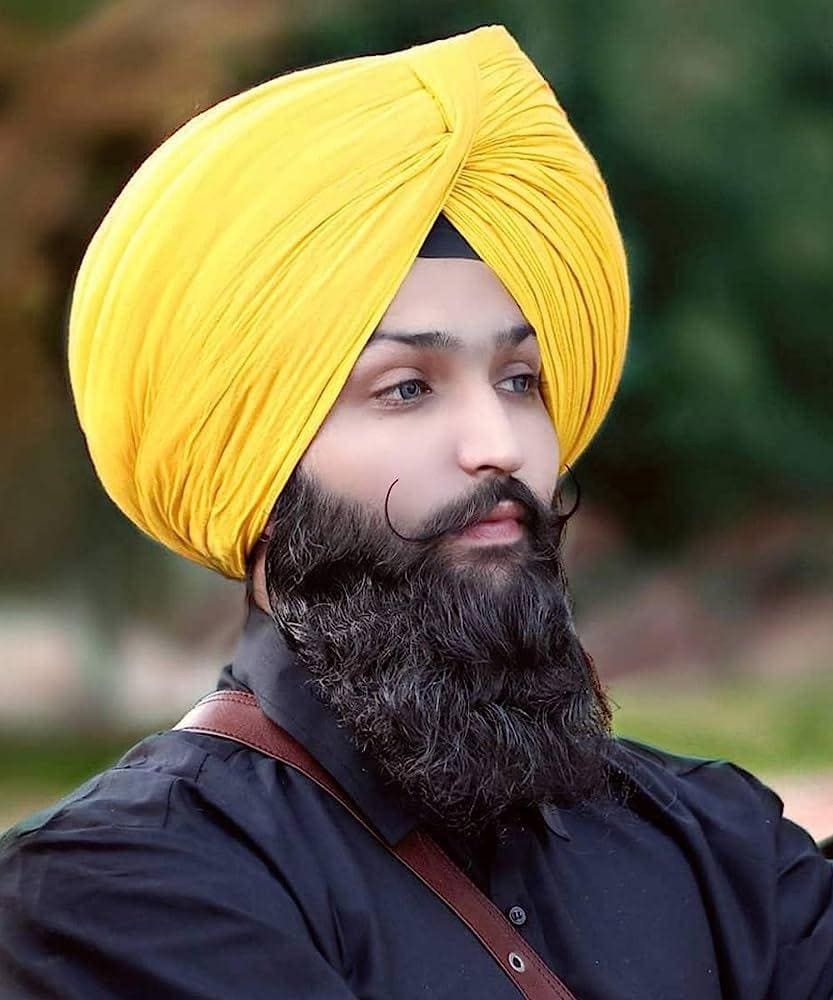
Chand Tora Dumalla
- Worn by Nihang Sikhs for battle.
- Features a metal symbol (Chand Tora) for protection.
- Ideal for a warrior-style appearance.
Widely embraced by Nihang Sikhs, the Chand Tora turban stands out as a warrior-style headwear crafted for the battlefield. This distinctive turban incorporates the “Chand Tora,” a metal symbol featuring a crescent and a double-edged sword. Positioned at the turban’s front, it is secured by a woven chainmail cord intricately tied within the turban, serving as protection against slashing weapons aimed at the head. The Chand Tora turban not only signifies strength and readiness for battle but also represents a rich martial tradition within Sikh culture.

Amritsari Dumalla:
- Slanting backward, distinct from Taksali Dumalla.
- Allows Amritdharis to carry Kirpans in side pouches.
- Crafted from specific materials in Amritsar.
Among Dhamala turbans, this style stands out as the most prevalent. Comprising two pieces, it includes a 5-meter section in Pavo Blue and an additional 11-meter piece available in various colors, with sabz (white) and pavo blue being popular choices. Both pieces measure 35 cm in width and are commonly recognized in Amritsar as Dhamala Material. This turban style reflects a widespread preference, showcasing simplicity and versatility in its design.
Taksali Dumala:

- Simple and basic Dumala style.
- Popular among Akhand Kirtan Jatha and Damdami Taksal.
The Taksali Dumalla is a unique and traditional Sikh turban style that holds special significance within the Akhand Kirtan Jatha and the Damdami Taksal communities. Known for its simplicity, this Dumalla style represents a preferred choice among Sikh individuals who align themselves with these religious groups. The Taksali Dumalla showcases the richness of Sikh heritage and identity through its distinctive wrapping and form, making it an integral part of the broader Sikh turban tradition.
Mughali Pagg:
- Adopted from Rajput tradition, worn by Mughals.
- Known as ‘Royal Indic Pagg.’
- Embraced by culturally traditional Sikhs.
The Mughali Pagg is a turban style deeply rooted in Sikh history and traditions. Originating from Rajput traditions, it found favor among the Mughals, starting with Akbar, and continued through subsequent Mughal rulers.
This distinctive turban style represents a fusion of Sikh identity with historical elegance, providing a visual connection to the rich heritage of the Sikh community. The Mughali Pagg serves as a symbol of cultural continuity and reverence for historical roots within the Sikh faith.
Darbara Singh Dumala:
- Named after the second Jathedar of the Budha Dal.
- Larger turban designed to hold multiple weapons.
- Features two loose cloths from the turban.
Recognized for its significant size, this turban holds historical importance among Nihang warriors. Its large form serves a practical purpose, providing ample space to carry various weapons. Worn by Nihang warriors, the Darbara Singh Dumala not only exemplifies a unique turban style within Sikh tradition but also symbolizes the martial spirit and preparedness associated with the Nihang tradition. The loose cloths hanging from the turban further contribute to its distinctive appearance, underscoring the historical and warrior ethos of Sikh heritage.
Barnala Shahi Pagg:
- Common Sikh Dastar style, longer with multiple wraps.
- Larh given a “V” shape for a modern Punjabi look.
- Prominent around the city of Barnala.
Wattan Wali Pagg:

- Larger size, worn by Sikhs proud of heritage.
- Divided in the middle due to numerous wraps at the top.
It symbolizes cultural pride and heritage among Sikhs. Distinguished by its larger size compared to other turbans, the Wattan Wali Pagg is a choice embraced by Sikhs who are avid learners and take immense pride in their heritage. The unique feature of being divided in the middle adds to its distinctive appearance, reflecting the deep connection Sikhs feel with their roots. The Wattan Wali Pagg stands as a testament to the wearer’s commitment to learning, cultural preservation, and a profound sense of pride in being part of the Sikh community.
Patiala Shahi Pagg:
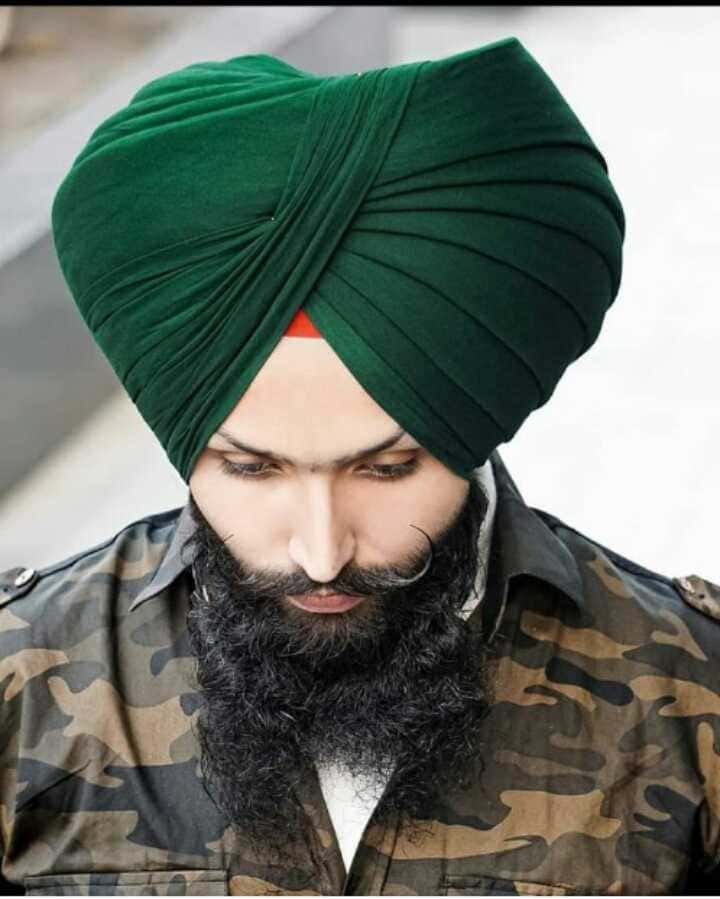
- Famous in the newer generation, tied by Maharaja Bhupinder Singh.
- Originated in Patiala, known as ‘Patiala Shahi.’
The Patiala Shahi Pagg is a turban style that emanates a sense of royal elegance and sophistication. Originating from the city of Patiala, this distinctive turban type gained fame through its first wearer, Maharaja Bhupinder Singh of Patiala. In the modern era, the Patiala Shahi Pagg has become widely popular among the newer generation. Its unique style, characterized by a longer length wrapping around the head, imparts a regal touch. This type of turban encapsulates a blend of tradition and contemporary flair, reflecting the rich history and evolving fashion sensibilities within the Sikh community.
Dastar Bunga:
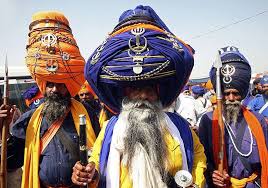
- Used by Akali Nihangs, essential for weapon storage.
- Original turban of the Khalsa Fauj, worn during battles.
- Integral to Akal-Nihang uniform traditions.
Dastar Bunga was the original turban worn by the Khalsa Fauj of the Gurus during battles. Guru Gobind Singh, the tenth Sikh Guru, introduced the turban-flag, adding to its significance. The dark blue tunic and turban, combined with symbolic elements, create a distinctive and magnificent appearance, embodying the valor and commitment of the Sikh warrior tradition.
Gurmukh Dastar:
- Worn by Amritdhari Sikhs and the current Akal Takht Jathedar.
- Known as ‘Gurmukhi Dastar’ worn by ‘Gurmukhs’ or ‘Gianis.’
The Gurmukh Dastar is a turban style worn by Amritdhari Sikhs, embodying a deep sense of devotion and spiritual commitment. This turban type is associated with individuals who have taken Amrit, signifying initiation into the Khalsa and a heightened commitment to Sikh principles. The Gurmukh Dastar serves as a visual representation of their religious dedication. Tied with precision and care, this turban stands as a symbol of spiritual consciousness and a conscious choice to live in accordance with the teachings of Sikhism.
Puratan Nok Pagg:
- Worn by British Sikh soldiers with Pharla and Shamla.
- Features a loose cloth extending from a Nok Pagg. The Puratan Nok Pagg stands as a tribute to the historical legacy of Sikh turbans, echoing the traditions of Sikh heritage. Often worn by Sikh soldiers during the British era, this turban style carries the essence of the past and the resilience of the Sikh community. Intriguingly, the Puratan Nok Pagg resembles the contemporary Nok Pagg, with a loose cloth extending from it. This style, worn by Sikh soldiers, may also include a Shamla (loose cloth) running down the back and a Turla (loose cloth) going from the side. It serves as a visual reminder of the Sikh community’s historical resilience and commitment to preserving its cultural identity.
- Amritsari Shahi Pagg:
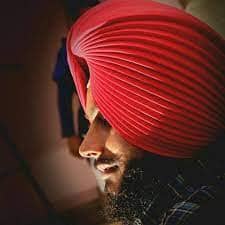
- Similar to Barnala Shahi Pagg but neater and sturdier.
- Top flap rotated straight to hold the turban together.
- Kenyan or UK Style Turban:

- Common among Sikh youth in the diaspora.
- Originated in Kenya, popularized in the UK.
- Known for its smart and elegant design.
The Keski – A Blend of Simplicity and Devotion: While the Pagg remains the most recognizable Sikh head covering, some Sikhs, particularly young boys and those engaged in sports or physical activities, opt for a smaller head covering known as the Keski. Offering a balance between practicality and religious commitment, the Keski allows individuals to uphold the practice of keeping their hair uncut (one of the Five Ks) while accommodating an active lifestyle.
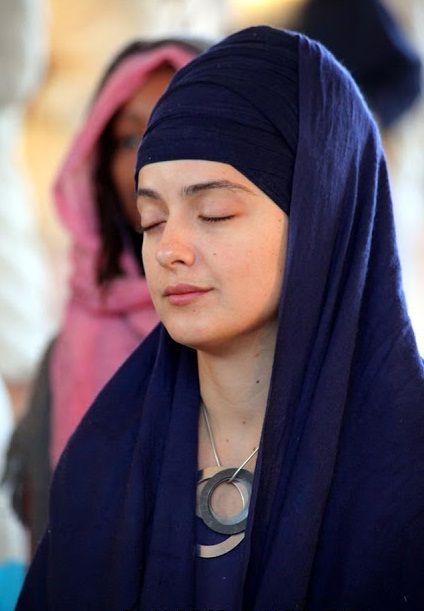
While not as elaborate as larger turbans, Keski styles showcase variations in tying techniques and appearances.
- Simple Knot Keski: This straightforward style involves tying the Keski in a simple knot on the top of the head. It provides a neat and secure covering, ideal for individuals on the go or those in active pursuits.
- Crossed Fold Keski: In this style, the fabric of the Keski is folded in a way that creates a cross-like pattern on the forehead. It adds a touch of uniqueness to the head covering while maintaining simplicity.
- Side Knot Keski: For a slightly asymmetrical look, some individuals prefer tying the Keski with a knot placed slightly off-center. This variation allows for a personalized and comfortable fit.
- Folded Edge Keski: Enhancing the aesthetics, the folded edge Keski involves neatly folding the fabric along the edges. This style not only adds a subtle design element but also ensures a clean and polished appearance.
- Printed or Patterned Keski: While maintaining the modest size of the Keski, individuals may choose fabrics with prints, patterns, or embroidery for added visual interest. This allows for personal expression within the parameters of Sikh modesty.
Dastār – Intrinsic to Sikh Identity: The Dastār, integral to Sikh culture, signifies values such as equality, honour, self-respect, courage, spirituality, and piety. Worn by Khalsa Sikh men and women who observe the Five Ks, the turban serves to cover their long, uncut hair (kesh). The Dastār is regarded as a crucial element of the distinctive Sikh identity, with its roots in the history of the Khalsa established by the tenth Sikh Guru, Guru Gobind Singh.
Patka Types in Sikh Culture
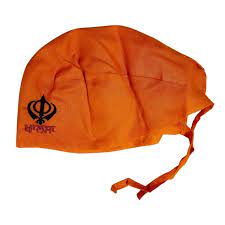
Patka, a small piece of cloth worn on the head, holds cultural significance in Sikhism, especially among young boys and individuals engaged in physical activities. Various types of Patkas exist, each reflecting personal preferences, regional influences, and practical considerations.

- Traditional Patka: This classic style features a square or rectangular piece of cloth,
- often in solid colors. It is a straightforward and functional choice for Sikh boys and individuals who prefer simplicity.
- Printed Patka: Infused with creativity, printed Patkas come in various patterns, colors, and designs. These vibrant options add a touch of personal flair while maintaining the practicality of head covering.
- Embroidered Patka: For those seeking an extra touch of elegance, embroidered Patkas showcase intricate designs or patterns along the edges. This style combines functionality with aesthetic appeal.
- Tying Styles: While the basic structure remains the same, individuals may adopt different tying styles for their Patkas, allowing for a customized look that aligns with personal comfort and preferences.

In Sikh culture, the Patka serves as a versatile head covering,
embodying the values of modesty, respect, and adherence to religious principles. The variety in Patka types reflects the diversity within the Sikh community and the importance of individual expression while upholding cultural traditions.
Challenges Encountered by Turban-Wearing Sikhs
In the terrorists attack in September 11, 2001 attacks in the USA, individuals donning the dastār, a prominent Sikh headwear, became targets of harassment. This was a result of some Americans mistakenly associating them with Muslims, who were being linked to acts of terrorism during that period. The resemblance of Sikh turbans to the one worn by Osama bin Laden in his iconic photograph contributed to this confusion.
In response to these challenges, the United States Department of Justice collaborated with the Sikh American Legal Defense and Education Fund (SALDEF) to create a poster aimed at familiarizing Americans with the distinctive appearance of Sikh turbans, seeking to mitigate misunderstandings and prevent unwarranted harassment.
Historical Significance of the Dastār: The Dastār has held importance in Sikhism since the time of the first Guru, Guru Nanak. It became a symbol of honour when passed down from Guru to Guru, emphasizing the succession and authority within the Sikh spiritual lineage. This practice continues to hold deep cultural and religious significance within the Sikh community.
Helmet Exemptions for Sikhs
In various regions around the world, Sikh that tie dastar while riding enjoy exemptions from legal obligations to wear helmets while riding motorcycles or bicycles, a significant element of Sikh identity. These countries were India and Nepal, as well as Canadian provinces such as Alberta, British Columbia, Ontario, and Manitoba. Also, in places like Malaysia, Hong Kong, Singapore, and Thailand, along with the United Kingdom. In Queensland, Australia, individuals riding bicycles and mobility scooters are exempt from mandatory helmet use, but this exception does not apply to motorcyclists.
But, it was not in past years as in 2008, Baljinder Badesha, a Sikh resident of Brampton, Ontario, Canada, faced legal challenges when he contested a $110 ticket for wearing a dastār instead of a helmet while riding his motorcycle, ultimately losing the case.
A notable development occurred in September 2016 when a court in Quebec, Canada, ruled that Sikh truck drivers at the Port of Montreal must wear hard hats when safety requirements dictate. This ruling effectively mandated the removal of their dastār, as the judge deemed their safety considerations to outweigh religious freedom. Previously, Sikh drivers could forego hard hats if they remained within their vehicles, but this practice extended loading times and was deemed commercially impractical.
Question: Why do Sikhs call small cloth under their turban as ‘Fifty’ or ‘Thathi’ ?
The term “Fifty” or “Thathi” in Sikh culture refers to a small piece of cloth that is generally worn underneath the turban. This piece of cloth serves multiple purposes within the Sikh tradition.
- Functional Use: The Fifty or Thathi is primarily used for practical reasons. It helps in securing and holding the hair neatly before tying the actual turban. By wrapping this small cloth around the hair, its ensured that the turban sits securely on the head, providing a foundation for the intricate turban-tying process.
- Comfort and Hygiene: The Fifty or Thathi also contributes to the comfort of wearing a turban. It helps in absorbing oil, sweat and keeping the hair clean, especially during hot weather or physical activities. This small cloth serves as a layer between the hair and the turban, promoting hygiene and overall comfort.
Question: Is tying a turban important or can i just wear a patka all the time?
While wearing a Patka is a valid option and does not diminish one’s commitment to Sikh principles, taking the time to tie a turban is encouraged.
Tying a turban not only looks more professional but is also in line with Sikh faith. The turban holds great importance in Sikhism, serving as a symbol of protection for the head and hair. It is often compared to a crown worn by kings and rulers, signifying the authority to rule over the mind. The turban is a foundational aspect of Sikhism, representing the protection of oneself and others.
However, it’s crucial to recognize that personal circumstances and preferences may lead individuals to choose different head coverings like a Patka, Saafa, or Parna. Ultimately, the key is to respect the diversity within the Sikh community and understand the cultural and religious values associated with these practices. The choice of head covering should align with one’s beliefs while maintaining a commitment to Sikh principles.
Question: Is it common for all Sikhs to wear turbans?
Answer: Sikhs do not simply wear turbans like caps. They practice the art of tying turbans. According to Sikhism rules, covering the head is mandatory.
Sikh men tie turbans, and Sikh women use a piece of cloth known as a Chunni.
Some Sikh women, who have embraced Amrit, also tie turbans. However, for women not ready to embrace Amrit, it’s optional to tie a turban or cover the head with a Chunni. Additionally, small Sikh kids cover their heads, but tying a turban is not necessary for them due to the difficulty of learning the process at an early age. Instead, they use a small piece of cloth called a Patka.
Question: Can a Sikh choose a different style of turban?
While there are recognized and traditional turban styles that serve as starting points, the flexibility within Sikh culture encourages individuals to invent and adopt their own unique Dastaar styles. The clean styled turban is appreciated by the community.
Question: Is one still regarded as a Sikh if they choose not to wear a turban but adhere to the other Five Ks?
Wearing a turban is one of the essential rules that a Sikh is expected to follow. Therefore, a Sikh who opts not to wear a turban is deviating from the principles of Sikhism, making them undisciplined within the context of the faith. To be a true Sikh, it is imperative to wear a turban if one is committed to keeping their hair.
Also, a turban holds significant social value, appreciated by various cultures such as Rajasthanis, Iranis, and Ottoman Turks. It serves as a symbol of dignity, responsibility, and nobility. Those who fail to recognize this significance may discard their turbans, but those who understand its value hold their turbans in high esteem.
Question: Would it be considered offensive to a Sikh if a non-Sikh wore a turban?
NO, its not offensive, as turbans are worn by various cultures worldwide, and may see it as a positive embrace of diversity. In fact, some Sikhs may feel proud to see individuals from different backgrounds appreciating and adopting the turban as a part of their attire.
YES, it could be offensive if the turban is being worn solely as a fashion statement without an understanding of its deep cultural and religious significance in Sikhism. Wearing a turban in Sikhism is not just a fashion choice; it represents respect for family, tradition, the Sikh Gurus, and the principles of Sikhism.
Factors that might lead to offense include mishandling or disrespect towards the turban, such as keeping it with sweaty or dirty clothes, allowing it to touch the floor or someone’s feet, tossing it casually, or wearing it improperly like a cap.
Some Sikhs even appreciate the recognition of their culture, it is essential for individuals, especially non-Sikhs, to approach wearing a turban with respect and awareness of its cultural and religious significance to avoid causing unintentional offense.






